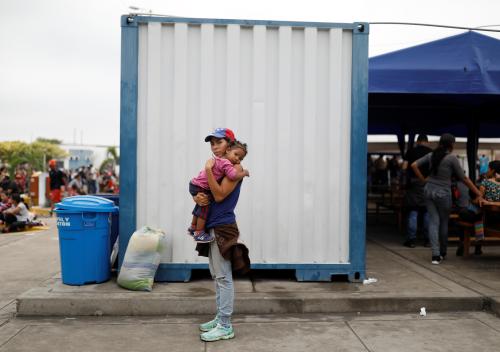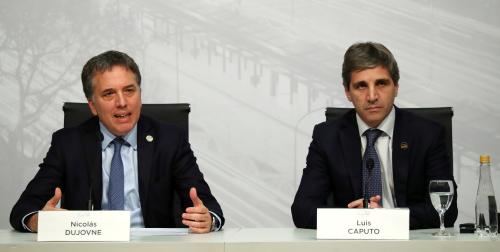Every year, the International Monetary Fund and World Bank meetings host a discussion on issues related to poverty reduction, international economic development, and finance. Given these two institutions’ presence and influence in sub-Saharan Africa, these meetings often deliver a range of policy prescriptions to improve these countries’ economic climates. So, what are the key takeaways for African countries from IMF and World Bank meetings that were held earlier this month in Lima, Peru?
While in recent years, these meetings have focused on the “Africa Rising” narrative, this year they centered on the continent’s recent falling GDP growth rate. For instance, the IMF forecasts that GDP growth in sub-Saharan Africa will slow to 3.75 percent in 2015, down from 5 percent in 2014, and its slowest pace since 2009. The case of sub-Saharan Africa’s two largest economies, which together account for more than half of the region’s GDP, is telling. While Nigeria’s growth will slow down to 4.0 percent in 2015 from 6.3 percent in 2014, South Africa will continue to muddle through with a 1.4 percent growth rate in 2015, about the same as last year’s (1.5 percent). In addition, given the region’s demographic trends, GDP per capita will drop to 1.4 percent from 2.6 percent in 2014.
This slowing GDP growth—driven by the deteriorating external environment witnessed in recent months—will noticeably impair the continent’s efforts towards achieving its sustainable development goals. Going forward, it will be important for African policymakers to have a two-pronged approach: They will need to “keep calm” and manage short-term macroeconomic shocks while at the same time maintain (or even accelerate) progress in medium- to long-term policy reforms.
In light of this larger challenge, other major themes and lessons emerged among policymakers present in Lima:
- Falling commodity prices and tightening financing conditions are eroding recent economic gains. Not surprisingly, oil-exporting countries will suffer the most under lower commodity prices. For example, in Nigeria, where oil and gas exports represent 75-80 percent of government revenues, lower commodity prices have reduced fiscal space and weakened the value of the naira. Still, the average growth forecast for Africa masks disparities among countries. While GDP growth in oil-exporting countries will fall to 3.6 percent in 2015 from 5.9 percent in 2014, continued infrastructure investment, coupled with strong private consumption have allowed growth in low-income countries on the continent to reach 5.9 percent down from 7.4 percent in 2014. Middle-income countries will grow at about the same pace as last year (2.6 percent in 2015 vs. 2.7 percent in 2014). However, without South Africa, growth in middle-income countries will reach 4.6 percent in 2015, down from 4.7 percent in 2014.
- Fiscal and current account deficits—especially for resource-rich countries—are increasing, and external borrowing costs are rising. The recent period of rapid growth has not been coupled with high savings, and countries are now entering this period of slow growth with high fiscal deficits. Tax revenues remain relatively low in sub-Saharan Africa at less than 15 percent of GDP on average and 13 percent of GDP for resource-rich countries. Subsidies continue to take a huge toll on African governments’ budgets. For instance, there are very few water and electricity distribution companies in the region that are financially sustainable and can operate without government subsidies. Current account deficits witnessed in numerous African countries have been mainly financed by increased influx of foreign investment. This trend could pose issues in the near future as the deteriorating global financing environment could reduce investment flows to sub-Saharan Africa. Another challenge to GDP growth in Africa is the increasing risk of debt, fueled by the inability to mobilize domestic resources, notably through fiscal means. African countries that have borrowed externally are becoming increasingly exposed to exchange rate risk. Countries that are considering borrowing externally will face higher costs as global interest rates are increasing, and investors are becoming more risk averse.
- Africa’s structural transformation agenda is still work in progress. Trade patterns continue to reveal a dependence on commodities: Growth has been largely driven by external demand, notably through the commodity exports to China. In addition, the continent has grown without structural transformation; in the last 20 years, the value chain has remained unaltered—Africa remains at the “primary goods export” stage of global production. In face of reduced commodity prices, African countries must learn to seek new engines of growth and learn to sustain growth in a context where commodity prices have significantly decreased. For example, Cape Verde’s government is reforming its budget by cutting subsidies and linking the tax structure to its growth engines, such as tourism.
- Adequate macroeconomic policies can help ride the current external shocks. Fiscal reforms in particular are important for oil exporters—with reduced oil revenues fiscal reforms become necessary. As governments’ ability to rely on these exports to fuel government income is reduced, countries must now turn to non-oil fiscal revenues—such as a value-added tax (VAT)—to fuel government revenues. In addition, given the reduction in policy buffers, countries must allow their exchange rates to depreciate in order to absorb economic shocks. This recommendation, however, is not appropriate for countries with a fixed exchange rate, such as the ones in the CFA franc zone. These countries will face a higher fiscal burden as they aim to adjust to these unsettling economic challenges.
- Domestic revenue mobilization should be a priority. African countries, notably resource-rich countries, have struggled with the ability to mobilize domestic resources, notably through fiscal means. Tax evasion and corruption are a major drain on the resources of developing countries. Mobilizing financing as a means to unlock the infrastructure gap and invest in human capital through the promotion of early childhood and STEM (science, technology, engineering, and mathematics) education is essential for spurring growth.
It is difficult to disagree with the economic diagnostic from the discussions in Lima, and we do not expect major disagreements on the policy measures that are needed to address the current challenges. It is now up to African policymakers to go back to the drawing board, consult with their countries’ stakeholders, and rapidly make the necessary policy adjustments. Waiting too long could prove disastrous. Growth is still in positive territory in spite of the recent shocks, but Africa’s room to maneuver has shrunk, and the global environment remains volatile.



Commentary
IMF and World Bank annual meetings: Africa’s Growth Losing Speed
October 29, 2015